Using a data-driven approach to invest in Atlanta’s children
The word “data” can conjure images of eye-crossing spreadsheets and digital labyrinths. But using data doesn’t need to feel daunting or complex. In Atlanta, Georgia, a cross-sector partnership used data to align values, center equity and chart a feasible path toward a shared vision.
In 2019, a pilot program invested over $2 million to enhance ten Atlanta schoolyards and open them up to community use. The City of Atlanta, along with Atlanta Public Schools (APS) and their nonprofit partners – the Trust for Public Land, KABOOM!, National League of Cities and the Children & Nature Network – recognized the power of this program in addressing existing disparities in access to nature and play spaces. The partners wanted to expand the program, placing equity at the center of their efforts. In 2023, they established a collective vision for Atlanta Community School Parks (ACSP), aiming to ensure that “by 2030, every Atlanta Public School should have a Community School Park that supports the healthy development, success and well-being of Atlanta’s kids and communities.” These kid-designed play spaces and outdoor learning environments would increase equitable access to healthy, green oases for all communities, both during and after school.
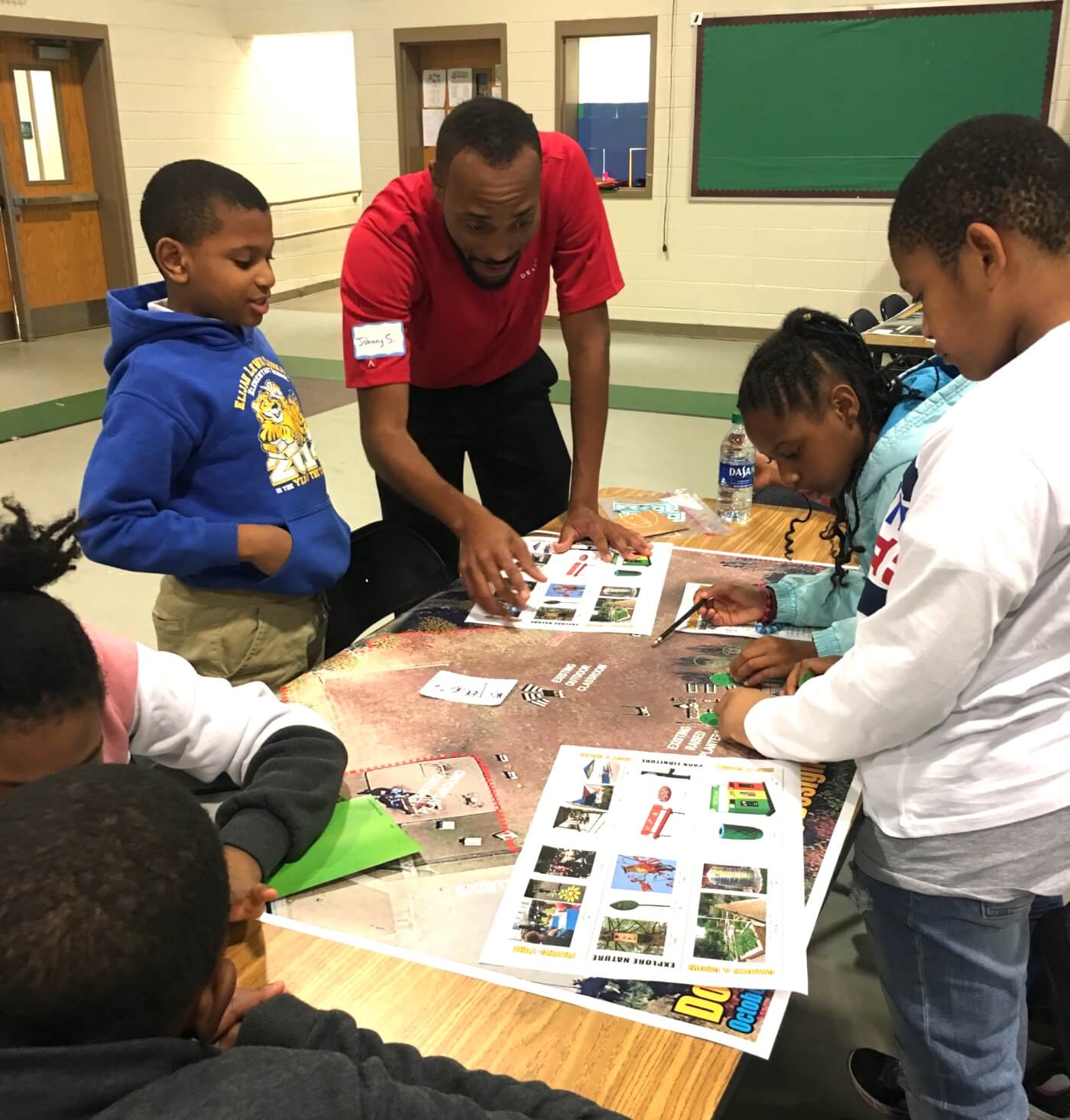
Students express their priorities and visions for their schoolyard. Photo by Trust for Public Land.
Given their districtwide goals, ACSP partners decided to prioritize equity in a phased approach, committing to transform a select number of schoolyards each year. Together they asked the question: How do we prioritize investments that are sure to reach the kids and communities most in need of nature and play access? They used data to get their answer.
The story of data analysis in Atlanta is bigger than number-crunching; it’s about establishing shared values and priorities. These conversations increased opportunities for collaboration and allocated resources more efficiently among a wide array of nonprofit, local government and community partners. The data discussions also established a new process for making decisions – one that puts equity at the forefront.
Here’s how Atlanta did it:
Bring your existing data and priorities
The Atlanta partners shared the ambitious goal of developing a “Community School Park” at every APS schoolyard. Eager to begin, they didn’t want to become mired in an onerous data collection process, especially since all participating organizations had already applied significant thought to their organization’s internal equity indicators. Instead, they assigned themselves a lighter lift: “Bring whatever data you already use to drive decision-making and prioritize equity.”
APS centered key equity indicators across their academic, facilities and equity departments, including everything from campus performing arts facilities to math scores. Parks & Recreation brought its Equity Data Tool, the Department of Watershed Management brought its stormwater infrastructure and water quality priority areas, Trust for Public Land employed its ParkServe and National Community Schoolyard data and KABOOM! brought its play inequity index. These combined indices – which also included race, income levels and other demographic characteristics – presented a comprehensive view of play and nature access, health, environmental justice and more.
ACSP partners also examined practical “readiness” factors: Where did partners already have facilities investments, green infrastructure enhancements or policy alignment underway?
Tell the stories and identify shared priorities
Each partner presented their data to the group and explained why their indicators matter for the communities they serve. For example, the Department of Watershed Management overlaid combined sewer area maps with APS school locations to prioritize sites where green stormwater infrastructure could most improve water quality and reduce stormwater runoff.
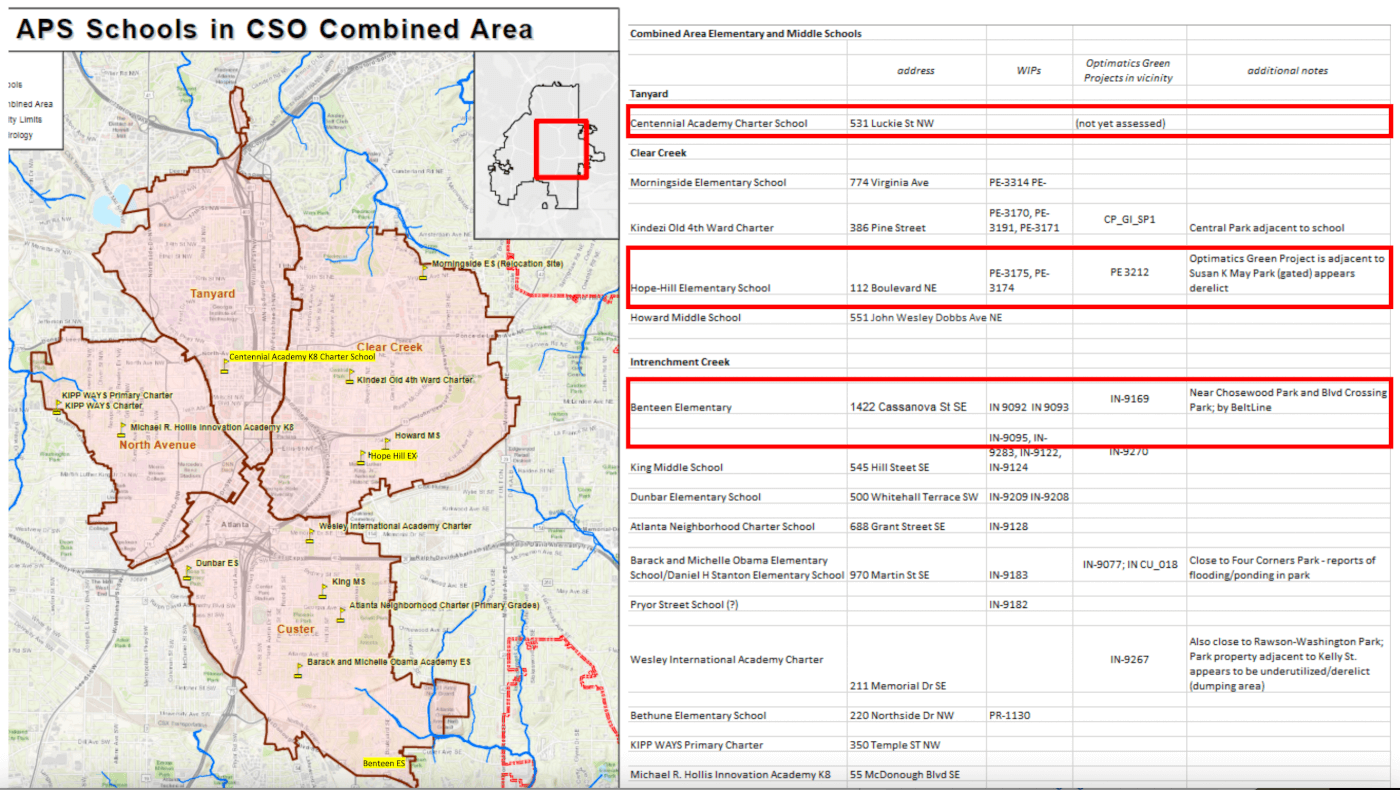
In order to identify priority schoolyard development sites, the Atlanta Department of Watershed looked at where Watershed Improvement Plan projects, schools in combined sewer areas and reports of flooding overlapped. Photo by Tamara Graham, Office of Watershed Protection, Atlanta Department of Watershed Management.
After listening to the presentations, partners reflected on the ways in which priorities diverged or aligned. Where there was overlap, they identified schools that could benefit the most from the development of a vibrant, nature-filled space in their neighborhood schoolyard. These 29 schools were then placed in a priority pool.
Among the collectively identified priority sites, Parks & Recreation saw two properties it was already primed to invest in and APS identified a third slated for facilities improvements. Three schools bubbled up to the top of the pool based on these readiness factors.
The partners knew they had considered some key information, but not all of it. The discussions needed to include qualitative information. APS leaders examined the priority pool and used their knowledge to fill in key context about facilities plans, additional partnerships and projects at those sites, as well as competing priorities of school principals. Collecting and considering all this information through conversations with community leaders allowed the group to further prioritize the pool of potential schoolyard sites into Tier 1, 2 and 3.
See the sites: Dive in and get wet
Data considerations would only be complete with physical visits to the potential schoolyard sites in order to more fully understand the current state of the physical spaces. Over two drizzly February days, partners strapped on rain gear and visited all Tier 1 and Tier 2 schoolyards. They wanted to further enrich existing data and stories with an understanding of the physical potential and experience of each priority site, examining features such as tree canopy, fencing, neighborhood accessibility and the presence of natural features.
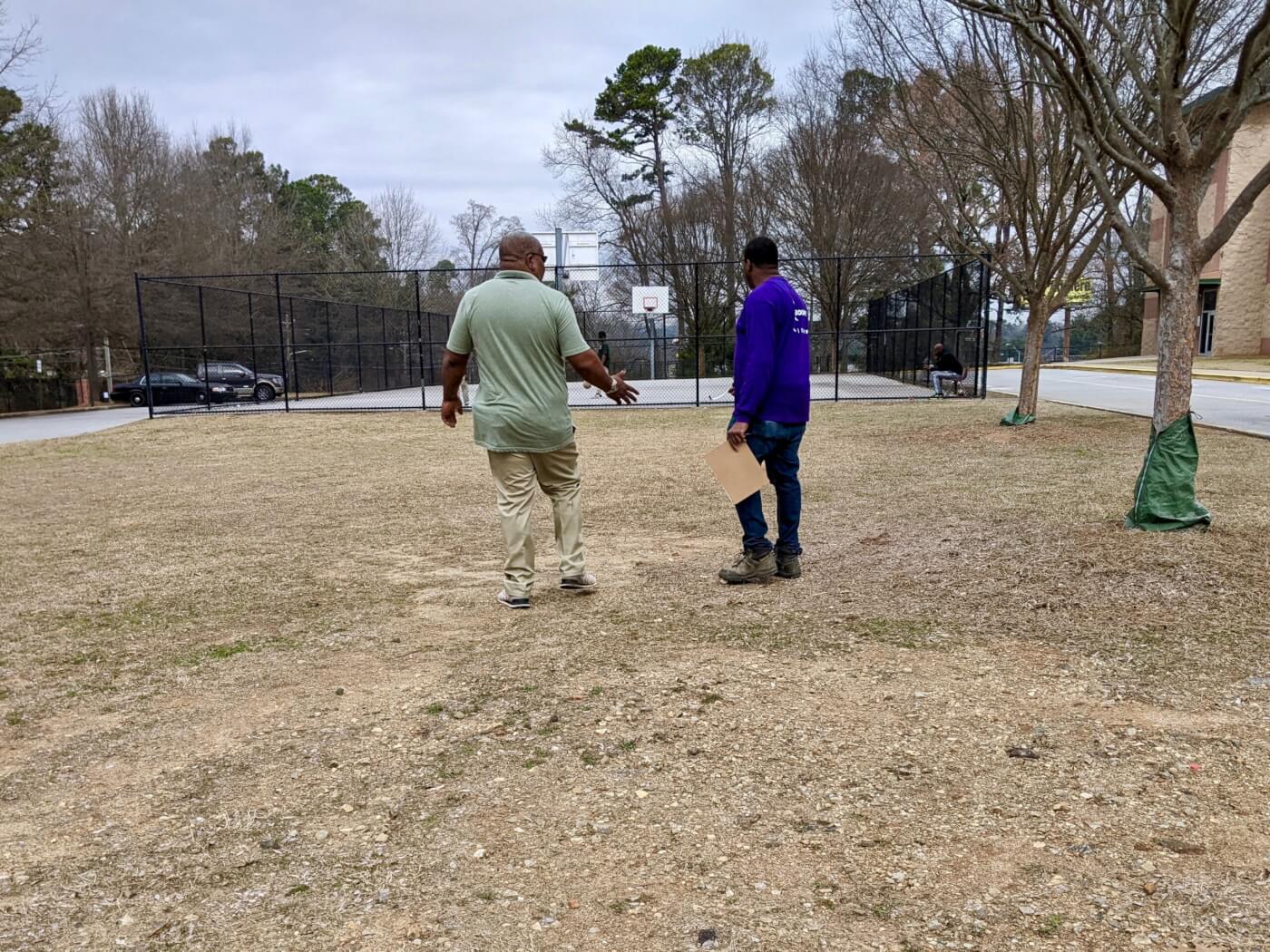
ACSP partners from APS and KABOOM! survey a schoolyard. Photo by Ruth Pimentel, Trust for Public Land
Co-create with schoolyard users
The Atlanta Community School Parks data conversation built a shared understanding among organizational partners of where priorities and resources lay. Agreement among collaborators is critical – including the most essential partners: community residents.
Currently, principals, teachers, grounds staff, families, neighbors and students are expressing their own priorities and visions for their schoolyards. It’s important for the ACSP partners to understand how to time investment and development in a way that best suits each community’s individual priorities.
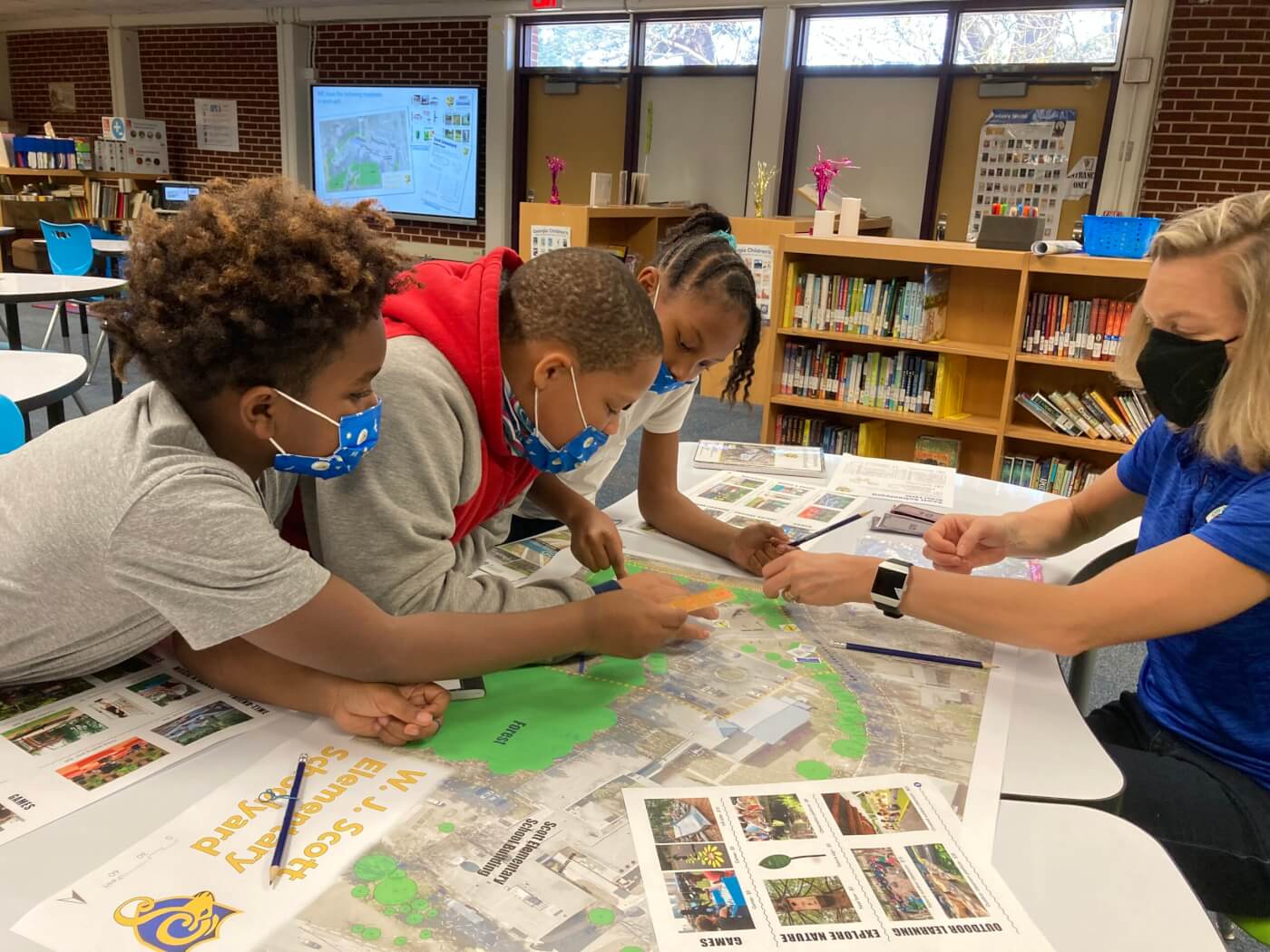
W.J. Scott Elementary School students collaborating on a vision for their schoolyard. Photo by Jay Wozniak, Trust for Public Land.
This process has produced tangible results for centering equity in the Atlanta Community School Parks initiative. Partners of the initiative now have a list of initial sites for their first year of co-design and implementation. The data has identified these sites as spaces where enhanced schoolyards would have the highest impact. The partners have also mapped out a phased process for achieving their vision of reimagining every Atlanta schoolyard in the most equitable and beneficial manner. This process can be improved and refined annually as collective priorities shift and partners learn and reflect in the coming years.
“When I first came to work here, it was difficult to have conversations across the aisle. Given that our city is growing, we realized we have to partner, and working with Atlanta Public Schools for the same children is a natural fit. The joint use agreement we’re putting together will be of great benefit to our whole city, and everybody is on board.” Tara Buckner, Atlanta Parks & Recreation
Atlanta’s schoolyard site selection offers an alternative to the all-too-common temptation to transform the “low-hanging fruit” sites or to respond to the squeakiest wheels in a district. The Atlanta Community School Park approach establishes partners’ commitment to equity, a strategy worthy of replication across the country.
Of equal importance: through rigorous reflection on shared data, partners are transforming the systems that impact Atlanta’s children and communities. Increased understanding of each other’s organizational values and complementary strengths deepen relationships across key agencies that serve Atlantans. So when local leaders examine spreadsheets, charts and maps, they don’t just see data. They see partners, opportunities and a deepened, shared commitment to align resources for healthier kids and healthier communities.
Atlanta’s team participates in the Cities Connecting Children to Nature green schoolyards technical assistance initiative, led by Children & Nature Network and the National League of Cities.
2 Comments
Submit a Comment
Schoolyard Inventory Tool, a Cities Connecting Children to Nature resource
Site Selection Tool, a Cities Connecting Children to Nature resource
National Community Schoolyard data tool, a Trust for Public Lands resource
TPL’s Community Schoolyards: Re-envisioning school grounds as public parks
-
Network News
POLICY UPDATE: Policy and advocacy for the children and nature movement
-
Voices
Binoculars, bald eagles and my journey as a Black birder
-
Richard Louv
THE WONDER BOWL: Ten Spring and Summer Nature Activities for Kids and Adults
-
Network News
Minneapolis Spotlight: The promise and possibilities of parks for youth
-
Voices
Why nature is my motherhood ally


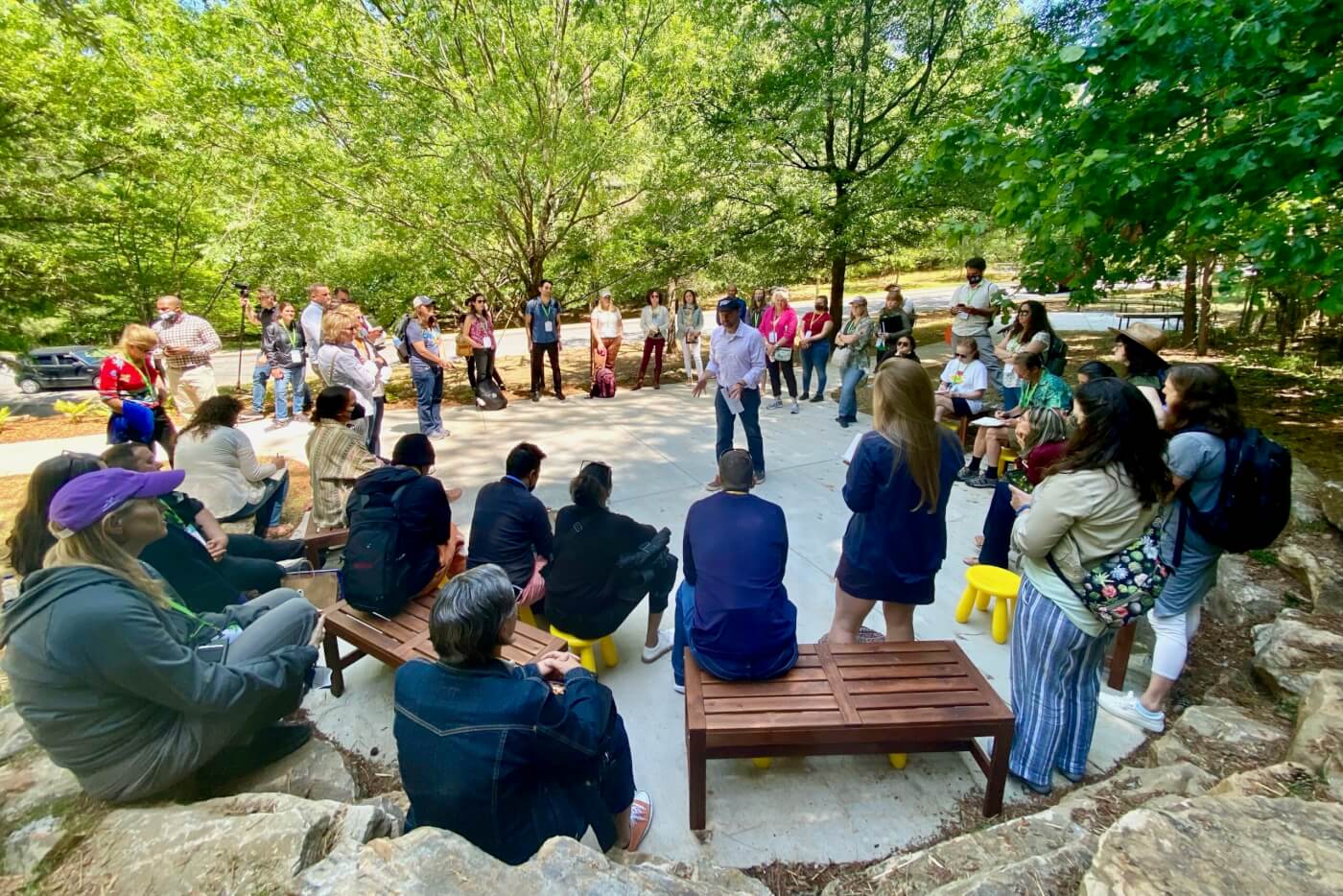
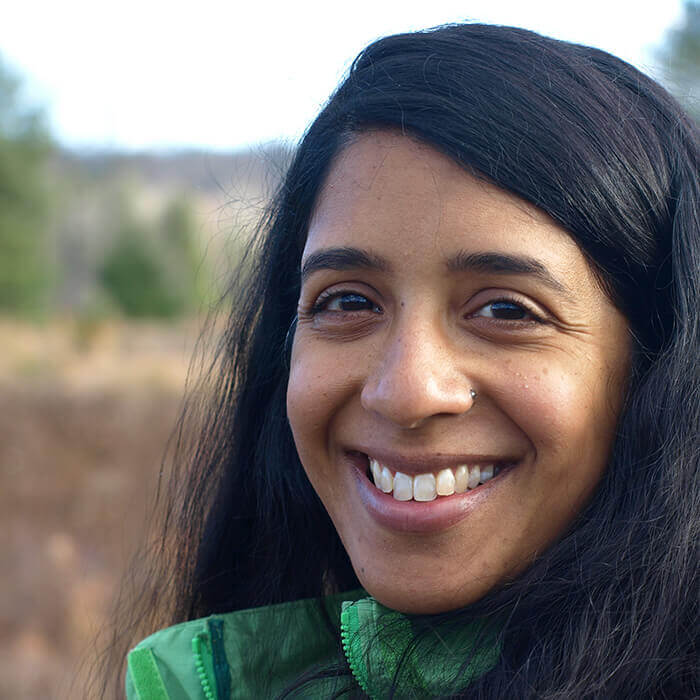



Thanks for this article Priya! Very interesting. Can’t wait to see the actual playgrounds once that part gets started. What a great model. Hope to see this in Richmond, CA and surrounds where I live.
Thank you for explaining the process! I love that all the decisions of what schoolyard to pick, how, and what is needed from the participant have been planned based on data from collaborative efforts of different organizations and sides. I am pretty sure whatever project comes after this caring process will be fruitful